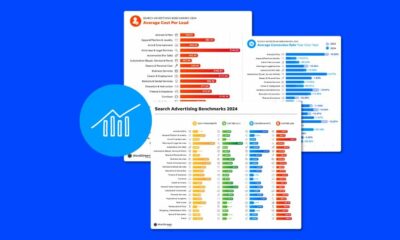SOCIAL
New Report Looks at Social Media Posting and News Consumption Trends in 2023
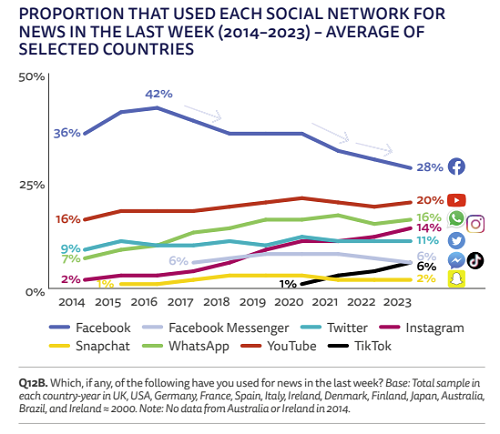
The Reuters Institute has released its annual review of news consumption trends, which, in many ways, also reflect broader online usage habits, and as such, it includes some valuable points of note for social media marketers that are looking to better connect with their audiences.
The report, conducted in partnership with YouGov, incorporates responses from almost 100,000 internet users, across 52 nations, and includes a heap of in-depth analysis of news engagement trends, as well as people’s views on algorithmic interference, left/right wing bias, criticism of media outlets, etc.
The full report comes in at a whopping 160 pages, so there’s plenty to dig deeper on. You can download the full report here, but in this post, we’ll take a look at some of the high level findings.
First off, the data shows that social media is now the preferred source of news content, overall, in comparison to accessing news publisher websites and apps direct.
As you can see in this chart, that’s especially pronounced in younger user groups, with those under the age of 24 (in the UK in this example) far more likely to rely on social media platforms to get news content, as opposed to visiting a publisher website direct.
That’s not great news for publishing providers, who generally get only a small portion of their referral traffic from social platforms, but this also may not account for those that end up tapping through to articles from a Google Search, for example, which remains the key traffic driver for most.
The data also shows that this behavior varies significantly by region, with users in Asia, Latin America, and Africa more likely to lean on social apps, while Asia-Pacific markets tend to turn to news aggregator sites, like Yahoo, to stay up to date.
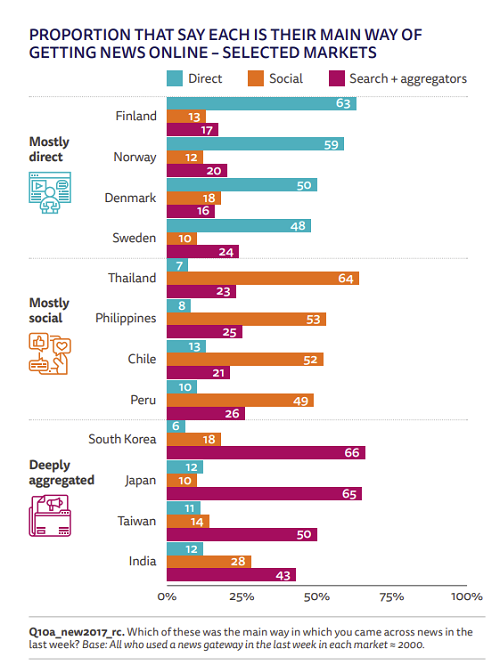
This is an important usage shift, which underlines the influence that social apps have in different regions – and it’d be interesting to also measure the health of the local media industry in regions where direct access remains strong, and how they’re driving ongoing support for their local press.
The data also provides some interesting insights into evolving social media usage habits, including this overview of how younger users are shifting their social media attentions over time.
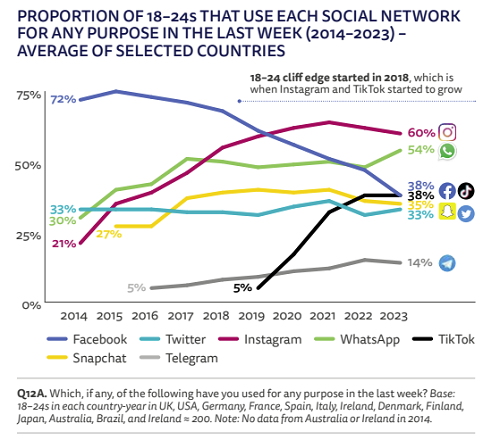
Facebook and Instagram are down, while TikTok and WhatsApp are up, as Snapchat and Twitter usage remains relatively stable (even after Elon Musk’s takeover at the app).
TikTok’s growing influence has been well documented, while the rise of WhatsApp reflects the broader trend away from public sharing, with users now far more inclined to post content in smaller, private groups, as opposed to subjecting themselves to potential scrutiny and judgment by sharing to the main social feed.
The same is also reflected in this chart:

People just aren’t looking to post their own thoughts an opinions at the same rate as they once were, due to reactive angst, potential division, as well as the never-ending memory of the internet, which has left people less inclined to use their social platforms as a means to broadcast their perspective.
That’s driven Meta, in particular, to make messaging a much bigger focus, while Twitter too is now exploring new ways to engage users within DMs, by improving the sharing experience. Meta’s own internal data has shown the same, that fewer people are posting to both Facebook and Instagram than they have in the past, and that trend is likely driving more people to turn to messaging apps, with the enhanced privacy of WhatsApp also offering additional assurance.
This also means that a smaller portion of users are now driving the social media news agenda, as fewer people are actively posting, which is another trend of note within the broader news consumption shift.
It is also worth noting that both Facebook and IG remain very popular overall, so it’s not like they’re dying out as critical drivers of connection. But the trends highlight TikTok’s rising influence, which has become a key entertainment source, along with the decreasing interest in posting for all to see.
This could also be a reflection of Dunbar’s Number theory, which states that humans can only ever maintain meaningful relationships with a maximum of 150 people at a time, no matter how hard we try. As such, there’s really no need to be broadcasting to everyone, or following hundreds of people, because for most, it’s only the smaller groups that you ever maintain any real connection with either way.
The early allure of social media was that we could all have our own broadcast channel, but it seems that, over time, we’re also becoming increasingly aware of the downsides that can come with that, and disinterested in such as a result.
In terms of news consumption specifically, Facebook remains the key driver among social apps, though it has declined significantly in recent years.
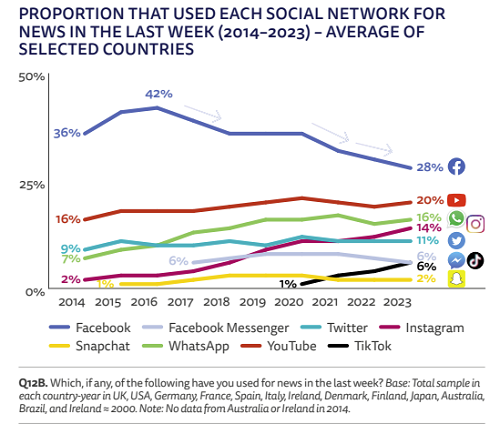
As per the report:
“Facebook remains the most important network (aggregated across 12 countries) at 28%, but is now 14 points lower than its 2016 peak (42%). Facebook has been distancing itself from news for some time, reducing the percentage of news stories people see in their feed (3% according to the company’s latest figures from March 2023), but in the last year it has also been scaling back on direct payments to publishers and other schemes that supported journalism. The growth of YouTube as a news source is often less noticed, but together with the rise of TikTok demonstrates the shift towards video-led networks.”
Video, overall, tends to drive more engagement, so it’s no surprise to see both YouTube and TikTok gaining traction here – though that may also raise more concerns about the potential influence that the Chinese Government may or may not have over how TikTok operates.
The report also notes that Twitter usage, as noted, remains strong since Elon took over, with Twitter users also more likely to be actively engaging with news discussion.
“Twitter users are more likely to pay attention to hard news subjects such as politics and business news than users of other networks, whereas TikTok, Instagram, and Facebook users are slightly more likely to consume fun posts (or satire) that relate to news.”
This has always been a key consideration for Twitter. While it might have fewer users overall, those who are actively engaging in tweets tend to be more in touch with the latest information, and are more likely to share their thoughts and opinions on such, which are often then aggregated to other networks. As such, Twitter’s influence is actually more significant than the raw numbers would suggest.
There’s a heap to dig into in the full report, which, again, is 160 pages long, so there’s no way I can do it justice here. If you’re interested in news trends, you’re better off downloading the whole thing, and taking in the specific points of interest.
You can access the full 2023 Reuters Institute Digital News Report here.
SOCIAL
12 Proven Methods to Make Money Blogging in 2024

 This is a contributed article.
This is a contributed article.
The world of blogging continues to thrive in 2024, offering a compelling avenue for creative minds to share their knowledge, build an audience, and even turn their passion into profit. Whether you’re a seasoned blogger or just starting, there are numerous effective strategies to monetize your blog and achieve financial success. Here, we delve into 12 proven methods to make money blogging in 2024:
1. Embrace Niche Expertise:
Standing out in the vast blogosphere requires focus. Carving a niche allows you to cater to a specific audience with targeted content. This not only builds a loyal following but also positions you as an authority in your chosen field. Whether it’s gardening techniques, travel hacking tips, or the intricacies of cryptocurrency, delve deep into a subject you’re passionate and knowledgeable about. Targeted audiences are more receptive to monetization efforts, making them ideal for success.
2. Content is King (and Queen):
High-quality content remains the cornerstone of any successful blog. In 2024, readers crave informative, engaging, and well-written content that solves their problems, answers their questions, or entertains them. Invest time in crafting valuable blog posts, articles, or videos that resonate with your target audience.
- Focus on evergreen content: Create content that remains relevant for a long time, attracting consistent traffic and boosting your earning potential.
- Incorporate multimedia: Spice up your content with captivating images, infographics, or even videos to enhance reader engagement and improve SEO.
- Maintain consistency: Develop a regular publishing schedule to build anticipation and keep your audience coming back for more.
3. The Power of SEO:
Search Engine Optimization (SEO) ensures your blog ranks high in search engine results for relevant keywords. This increases organic traffic, the lifeblood of any monetization strategy.
- Keyword research: Use keyword research tools to identify terms your target audience searches for. Strategically incorporate these keywords into your content naturally.
- Technical SEO: Optimize your blog’s loading speed, mobile responsiveness, and overall technical aspects to improve search engine ranking.
- Backlink building: Encourage other websites to link back to your content, boosting your blog’s authority in the eyes of search engines.
4. Monetization Magic: Affiliate Marketing
Affiliate marketing allows you to earn commissions by promoting other companies’ products or services. When a reader clicks on your affiliate link and makes a purchase, you get a commission.
- Choose relevant affiliates: Promote products or services that align with your niche and resonate with your audience.
- Transparency is key: Disclose your affiliate relationships clearly to your readers and build trust.
- Integrate strategically: Don’t just bombard readers with links. Weave affiliate promotions naturally into your content, highlighting the value proposition.
5. Display Advertising: A Classic Approach
Display advertising involves placing banner ads, text ads, or other visual elements on your blog. When a reader clicks on an ad, you earn revenue.
- Choose reputable ad networks: Partner with established ad networks that offer competitive rates and relevant ads for your audience.
- Strategic ad placement: Place ads thoughtfully, avoiding an overwhelming experience for readers.
- Track your performance: Monitor ad clicks and conversions to measure the effectiveness of your ad placements and optimize for better results.
6. Offer Premium Content:
Providing exclusive, in-depth content behind a paywall can generate additional income. This could be premium blog posts, ebooks, online courses, or webinars.
- Deliver exceptional value: Ensure your premium content offers significant value that justifies the price tag.
- Multiple pricing options: Consider offering tiered subscription plans to cater to different audience needs and budgets.
- Promote effectively: Highlight the benefits of your premium content and encourage readers to subscribe.
7. Coaching and Consulting:
Leverage your expertise by offering coaching or consulting services related to your niche. Readers who find your content valuable may be interested in personalized guidance.
- Position yourself as an expert: Showcase your qualifications, experience, and client testimonials to build trust and establish your credibility.
- Offer free consultations: Provide a limited free consultation to potential clients, allowing them to experience your expertise firsthand.
- Develop clear packages: Outline different coaching or consulting packages with varying time commitments and pricing structures.
8. The Power of Community: Online Events and Webinars
Host online events or webinars related to your niche. These events offer valuable content while also providing an opportunity to promote other monetization avenues.
- Interactive and engaging: Structure your online events to be interactive with polls, Q&A sessions, or live chats. Click here to learn more about image marketing with Q&A sessions and live chats.
9. Embrace the Power of Email Marketing:
Building an email list allows you to foster stronger relationships with your audience and promote your content and offerings directly.
- Offer valuable incentives: Encourage readers to subscribe by offering exclusive content, discounts, or early access to new products.
- Segmentation is key: Segment your email list based on reader interests to send targeted campaigns that resonate more effectively.
- Regular communication: Maintain consistent communication with your subscribers through engaging newsletters or updates.
10. Sell Your Own Products:
Take your expertise to the next level by creating and selling your own products. This could be physical merchandise, digital downloads, or even printables related to your niche.
- Identify audience needs: Develop products that address the specific needs and desires of your target audience.
- High-quality offerings: Invest in creating high-quality products that offer exceptional value and user experience.
- Utilize multiple platforms: Sell your products through your blog, online marketplaces, or even social media platforms.
11. Sponsorships and Brand Collaborations:
Partner with brands or businesses relevant to your niche for sponsored content or collaborations. This can be a lucrative way to leverage your audience and generate income.
- Maintain editorial control: While working with sponsors, ensure you retain editorial control to maintain your blog’s authenticity and audience trust.
- Disclosures are essential: Clearly disclose sponsored content to readers, upholding transparency and ethical practices.
- Align with your niche: Partner with brands that complement your content and resonate with your audience.
12. Freelancing and Paid Writing Opportunities:
Your blog can serve as a springboard for freelance writing opportunities. Showcase your writing skills and expertise through your blog content, attracting potential clients.
- Target relevant publications: Identify online publications, websites, or magazines related to your niche and pitch your writing services.
- High-quality samples: Include high-quality blog posts from your site as writing samples when pitching to potential clients.
- Develop strong writing skills: Continuously hone your writing skills and stay updated on current trends in your niche to deliver exceptional work.
Conclusion:
Building a successful blog that generates income requires dedication, strategic planning, and high-quality content. In today’s digital age, there are numerous opportunities to make money online through blogging. By utilizing a combination of methods such as affiliate marketing, sponsored content, and selling digital products or services, you can leverage your blog’s potential and achieve financial success.
Remember, consistency in posting, engaging with your audience, and staying adaptable to trends are key to thriving in the ever-evolving blogosphere. Embrace new strategies, refine your approaches, and always keep your readers at the forefront of your content creation journey. With dedication and the right approach, your blog has the potential to become a valuable source of income and a platform for sharing your knowledge and passion with the world, making money online while doing what you love.
Image Credit: DepositPhotos
SOCIAL
Snapchat Explores New Messaging Retention Feature: A Game-Changer or Risky Move?

In a recent announcement, Snapchat revealed a groundbreaking update that challenges its traditional design ethos. The platform is experimenting with an option that allows users to defy the 24-hour auto-delete rule, a feature synonymous with Snapchat’s ephemeral messaging model.
The proposed change aims to introduce a “Never delete” option in messaging retention settings, aligning Snapchat more closely with conventional messaging apps. While this move may blur Snapchat’s distinctive selling point, Snap appears convinced of its necessity.
According to Snap, the decision stems from user feedback and a commitment to innovation based on user needs. The company aims to provide greater flexibility and control over conversations, catering to the preferences of its community.
Currently undergoing trials in select markets, the new feature empowers users to adjust retention settings on a conversation-by-conversation basis. Flexibility remains paramount, with participants able to modify settings within chats and receive in-chat notifications to ensure transparency.
Snapchat underscores that the default auto-delete feature will persist, reinforcing its design philosophy centered on ephemerality. However, with the app gaining traction as a primary messaging platform, the option offers users a means to preserve longer chat histories.
The update marks a pivotal moment for Snapchat, renowned for its disappearing message premise, especially popular among younger demographics. Retaining this focus has been pivotal to Snapchat’s identity, but the shift suggests a broader strategy aimed at diversifying its user base.
This strategy may appeal particularly to older demographics, potentially extending Snapchat’s relevance as users age. By emulating features of conventional messaging platforms, Snapchat seeks to enhance its appeal and broaden its reach.
Yet, the introduction of message retention poses questions about Snapchat’s uniqueness. While addressing user demands, the risk of diluting Snapchat’s distinctiveness looms large.
As Snapchat ventures into uncharted territory, the outcome of this experiment remains uncertain. Will message retention propel Snapchat to new heights, or will it compromise the platform’s uniqueness?
Only time will tell.
SOCIAL
Catering to specific audience boosts your business, says accountant turned coach

While it is tempting to try to appeal to a broad audience, the founder of alcohol-free coaching service Just the Tonic, Sandra Parker, believes the best thing you can do for your business is focus on your niche. Here’s how she did just that.
When running a business, reaching out to as many clients as possible can be tempting. But it also risks making your marketing “too generic,” warns Sandra Parker, the founder of Just The Tonic Coaching.
“From the very start of my business, I knew exactly who I could help and who I couldn’t,” Parker told My Biggest Lessons.
Parker struggled with alcohol dependence as a young professional. Today, her business targets high-achieving individuals who face challenges similar to those she had early in her career.
“I understand their frustrations, I understand their fears, and I understand their coping mechanisms and the stories they’re telling themselves,” Parker said. “Because of that, I’m able to market very effectively, to speak in a language that they understand, and am able to reach them.”Â
“I believe that it’s really important that you know exactly who your customer or your client is, and you target them, and you resist the temptation to make your marketing too generic to try and reach everyone,” she explained.
“If you speak specifically to your target clients, you will reach them, and I believe that’s the way that you’re going to be more successful.
Watch the video for more of Sandra Parker’s biggest lessons.
-

 PPC6 days ago
PPC6 days agoHow the TikTok Algorithm Works in 2024 (+9 Ways to Go Viral)
-

 SEO5 days ago
SEO5 days agoHow to Use Keywords for SEO: The Complete Beginner’s Guide
-

 MARKETING6 days ago
MARKETING6 days agoHow To Protect Your People and Brand
-

 MARKETING4 days ago
MARKETING4 days agoAdvertising on Hulu: Ad Formats, Examples & Tips
-

 MARKETING5 days ago
MARKETING5 days agoUpdates to data build service for better developer experiences
-

 MARKETING5 days ago
MARKETING5 days agoThe Ultimate Guide to Email Marketing
-

 WORDPRESS4 days ago
WORDPRESS4 days agoBest WordPress Plugins of All Time: Updated List for 2024
-

 SEO7 days ago
SEO7 days agoAutomate Multi-Site Reporting With Google Sheets And GSC API




